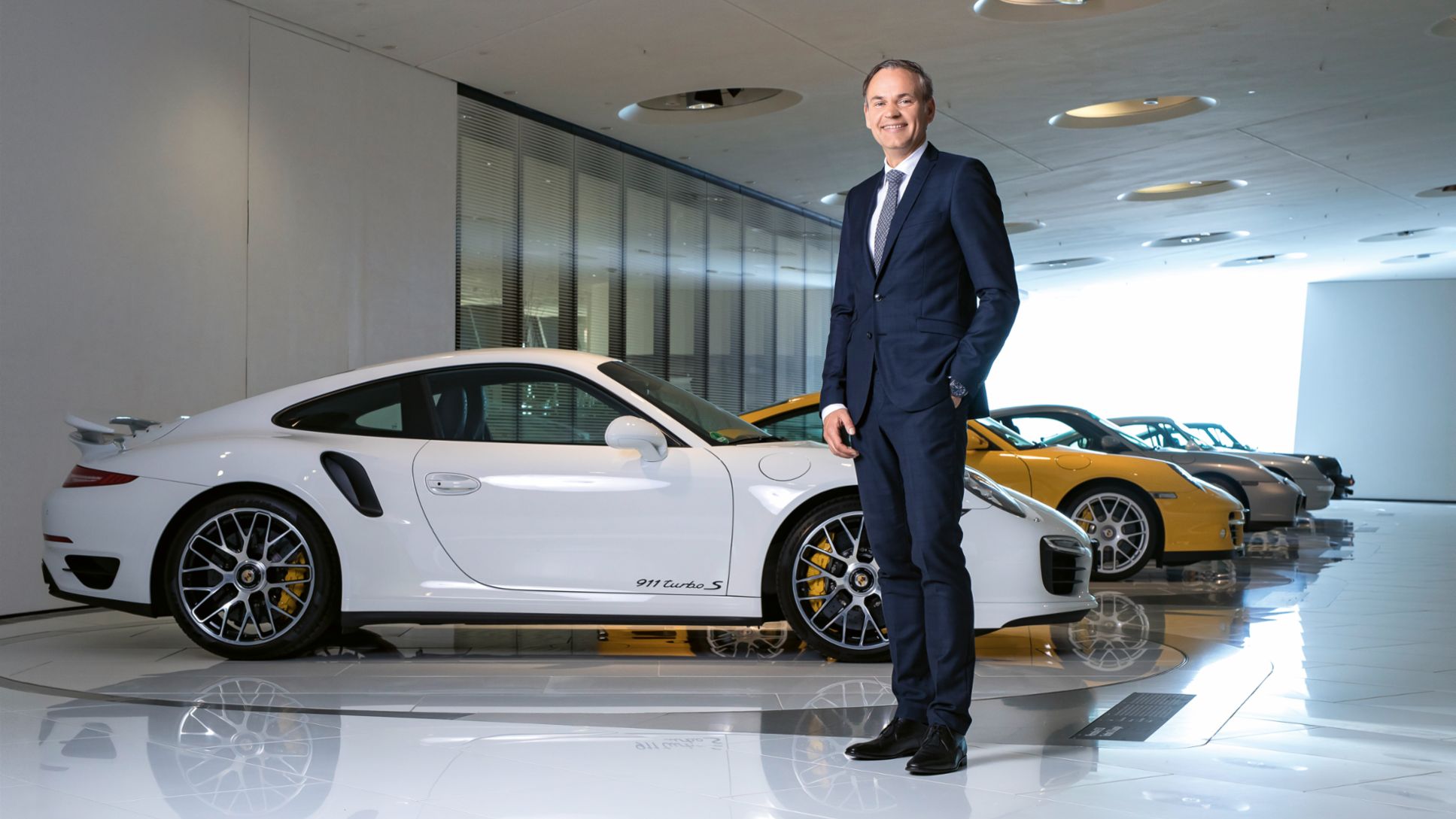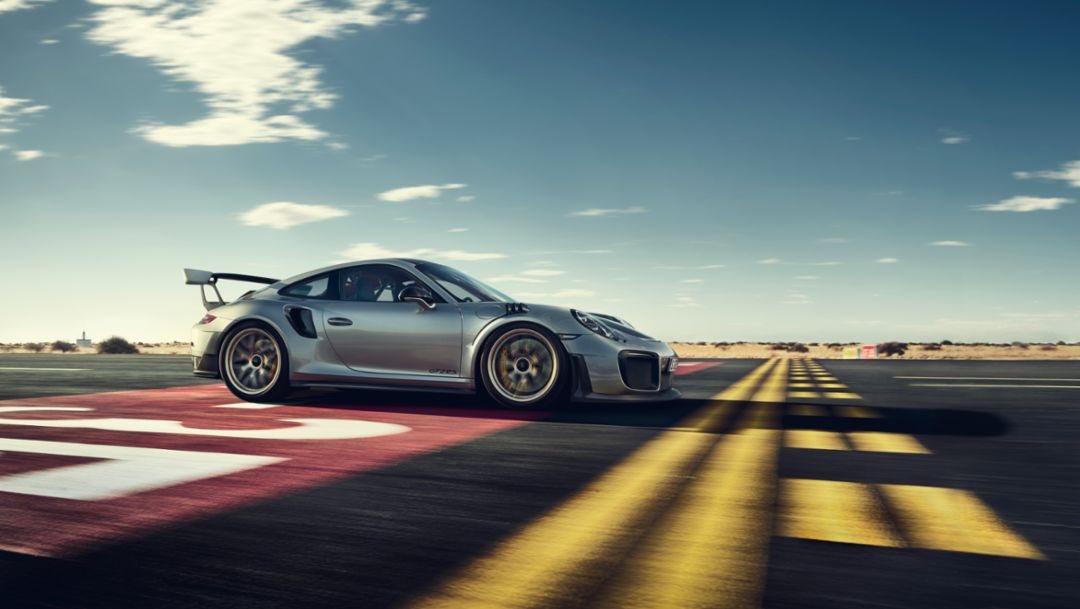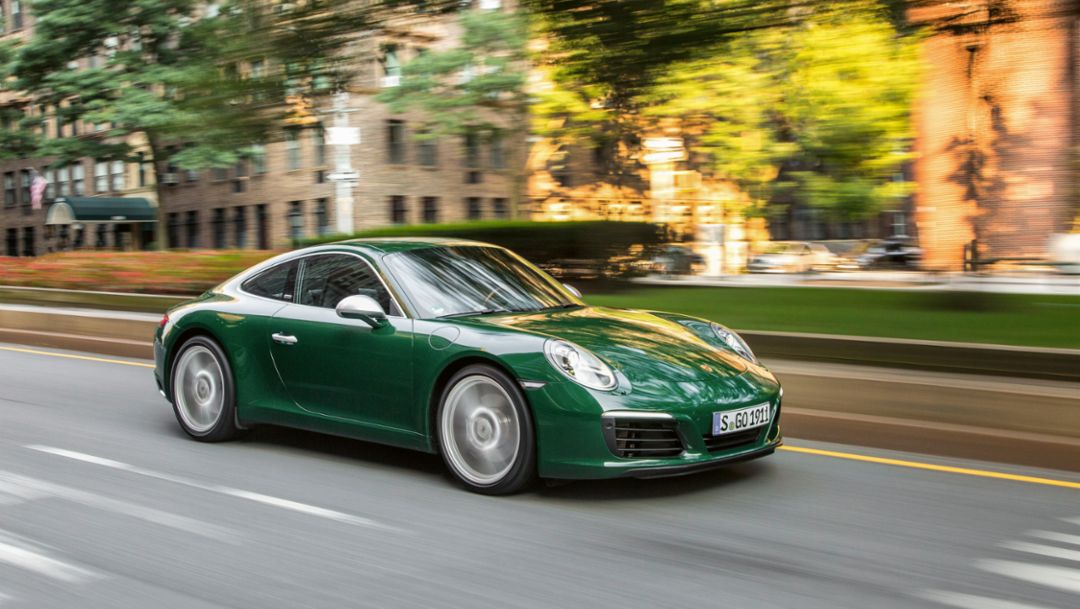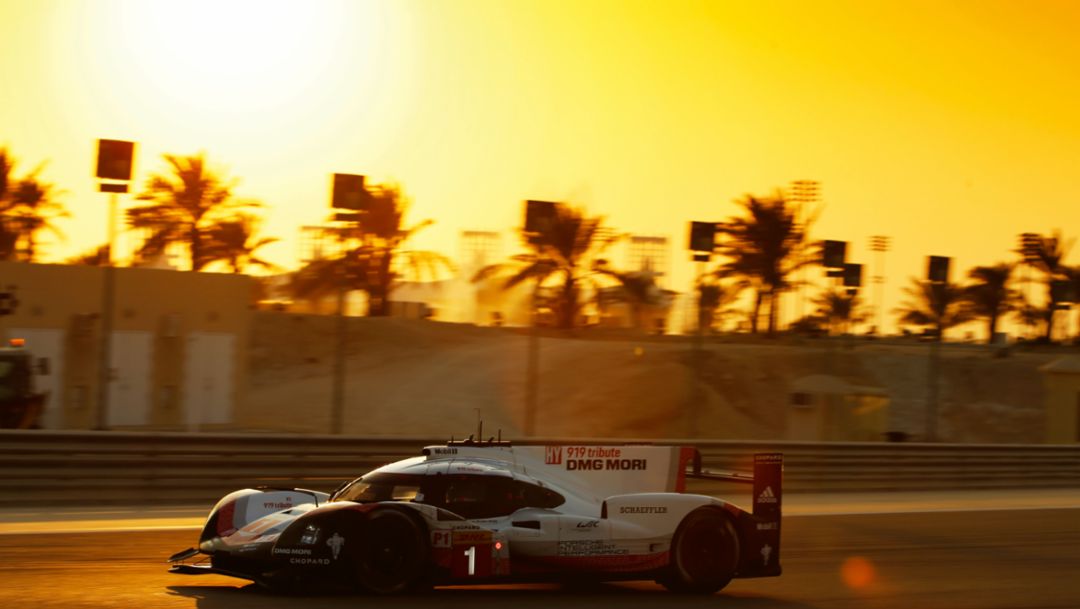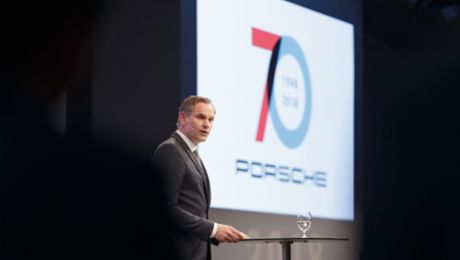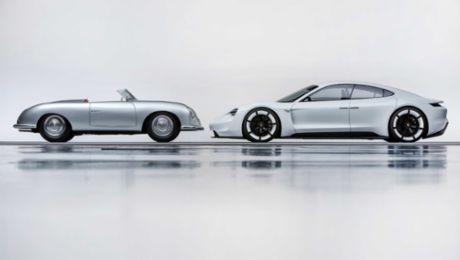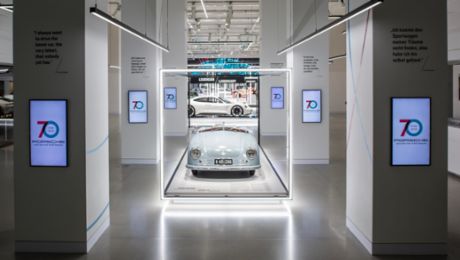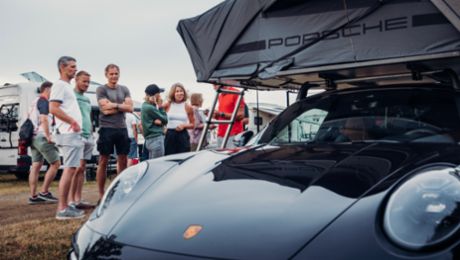Mr Blume, let’s look into our crystal ball for a moment. When will we see the last Porsche with a combustion engine?
I would venture to predict that, by 2030, the sportiest Porsche will have an electric drive. Who knows – maybe by then even our iconic sports car, the 911, will be electric.
Does this mean that you have already decided to leave behind conventional drive concepts completely?
On the contrary! It would be absurd to think that we could do without the combustion engine completely in the foreseeable future. But, equally, we cannot miss the opportunity to invest heavily in electromobility. Before we leave petrol or diesel behind, the next decade will see an increase in the parallel use of combustion engines and alternative drives. A clear trend is developing, and we will deliver. I am not going to do anything hasty, however.
Would a decision to abandon diesel engines at Porsche be hasty?
At Porsche, diesel engines have traditionally taken a back seat. Diesel’s share among our vehicles worldwide is currently 14 per cent. Porsche does not develop or manufacture its own diesel engines, and there are no plans to change that in the future. All the same, there’s no reason to just suddenly abandon diesel. If we rushed into dropping diesel, we would not be able to completely make up the difference with petrol and hybrid engines. Furthermore, diesel makes an important contribution to achieving our CO2 targets. There are many markets, such as in Southern Europe, where people really don’t understand Germany’s current discussion about the future of diesel. There, 80 per cent of customers buy a diesel car. That is why a mixture of combustion engines, hybrids and electric cars is the right strategic response from Porsche for about the next ten years.
Why can the transition to electromobility not happen faster?
There are technical and structural reasons for it, but also purely economic ones. To begin with, the everyday usability of electric cars needs to continue to improve – particularly in terms of range and charging time. There is also quite a bit to be done when it comes to infrastructure. The pan-European high-power charging network IONITY by Porsche, Audi, BMW, Daimler and Ford is now charting a course towards the establishment of the most powerful fast-charging network for electric vehicles in Europe. But even this can only be one part of a larger solution. The second reason for the delay is connected to doubts regarding whether the current electricity mix is really better for the climate than combustion engines. Thirdly, people often fail to realise the Herculean task faced by our industry, which is, after all, the backbone of our economy and our welfare state.
Increasingly strict emission regulations within the EU, which will mean that new cars in 2030 will have to have 30 per cent lower emissions than those in 2021, will force you to continue to invest a lot of money in existing technologies and their advancement...
... Investments across the entire industry are enormous. The Volkswagen Group, to which Porsche belongs, is ramping up its investments in new, electric-drive models to 20 billion euros by 2030. By 2025, the Group’s brands expect to put more than 80 new car models with e-motors on the market, including 50 pure e-cars and 30 plug-in hybrids. Porsche alone will invest more than six billion euros in plug-in hybrids and purely electric vehicle over the next five years. For a company of our size, that is a considerable expenditure. At Porsche’s headquarters in Zuffenhausen, we are spending a billion euros on building a new plant for electric vehicles. This is probably the most ambitious and risky project we have ever undertaken. A factory within the factory with 1,200 new jobs.
Will costs of that magnitude pay off?
They are investments in the future. But, one thing is sure: our customers, too, are price-sensitive, even if they are ready to pay a premium price for a Porsche. Even Porsche cannot simply pass on the costs of electrification of its vehicles if, as expected, the competition is stiff. We have to be able to earn the added value. This may – as one would expect – have a short- or medium-term effect on our profitability, but it need not do so if we manage to compensate for it with other measures. We see various approaches and are looking forward to the challenge.
In 2019, the Mission E will roll off the assembly line in Zuffenhausen. You intend this battery only vehicle to be not only the first emission-free Porsche, but also one produced with an entirely CO2-neutral footprint.
And we’ll achieve that goal, too. Well over a year ago, we switched all our plants to 100% natural electricity sources, which underlines how seriously we take sustainability. The Mission E will not only redefine the high-performance e-vehicle segment, it will also give a boost to Germany as a technology producer and thus to possibilities offered by electromobility in general. The vehicle will be a trailblazer for the mass appeal of e-vehicles. It will set standards and will represent motion in more than one sense. The only things that the Mission E will not offer are boredom and forbearance.
Porsche as the pacesetter of a new automobile era?
Why not? Porsche invented the hybrid drive. And, over the last three years, we have dominated the Endurance World Championship from a technological standpoint like no other brand ever before, thanks to our hybrid and battery technology and our visions of downsizing and increased efficiency. Take, for example, our 19th overall victory in Le Mans. Mediocrity doesn’t win the race. Top performance and pushing the boundaries are what is needed to unleash forces and captivate others.
Despite all the pressure created by this change, Porsche seems to speed from one record year to the next – more cars, higher turnover, higher profits, more employees and a return that can be counted among the best in the industry. Did you reach your peak in 2017?
Let’s wait and see. Inspiring products are what drives us forward; figures are merely the result.
Your current figures have set a record, however.
We are pleased about the record turnover and top numbers for car deliveries, but they are not our top priority. Satisfied customers are the only yardstick for our success. Naturally we are proud of what we have achieved. Naturally it’s nice that our customers are reminded of the 911 whether they are in a Macan, a Cayenne or a Panamera. And of course we benefit from new growth spurts such as those in China. But all that is a positive snapshot. We think of success differently.
In what way?
We focus on growth that creates value. This growth is oriented towards four primary goals. Firstly, inspiring customers with a unique product and brand experience. Secondly, excellent earning power. Thirdly, innovation and sustainable actions. And, fourthly, attractiveness as an employer and an economic partner. Customers want inspiring automobiles. We need capital for investments and innovations. The success of our company depends on whether we can retain enough talent. If you want to create sustainable value in the long term, you not only need to understand the connection between economic returns and value creation for humans and the environment, you also need to be seen to live these values as part of a society that has increasingly ecologically and socially minded attitudes.
What does a chairman of the board need to have to be able to push forward ideas that fundamentally change a company?
Personally, I am convinced that you cannot achieve the type of change that we are currently putting into place either on one’s own or with individual measures. You need a good deal more – a persuasive team, ideas, courage, passion and a well-thought-out and flexible strategy. The important thing is to recognise what needs to be done, and then to tackle it, show others the lead by your own actions, and take responsibility. This starts with myself. Only someone who has a sense of responsibility will be able to change things and drive forward that change. And that is precisely our aim: we want to change Porsche without neglecting the things that made us strong.
Which means what, exactly?
To take one example, one of Porsche’s roots is motor racing. We are currently transferring our experience and lessons learned from decades of motor racing and thousands of victories from our sports-car prototypes to Formula E. We are thus taking on a new challenge but remaining true to our past: for us, motor racing exists to help us build better cars for road use. Formula E is exactly the same – it is the ultimate laboratory for our electrification strategy. The future of the sports car combines our tradition and values with new, sustainable technologies and a very emotional driving experience. I can promise that the Mission E will be the sportiest and the most technologically advanced vehicle in its class. E-mobility, Porsche performance and driving enjoyment are not mutually exclusive; for us, they all belong together.
You are in your third year as Chairman of the Executive Board at Porsche AG. What exactly has changed?
We are moving at high speed through a time of huge technological advances. The path for the sports car of the future has been laid. Creativity is considered very important. We know where we’re coming from but we also know where we want to go. We have been able to build on the very good foundation laid by my predecessor Matthias Müller and have moved Porsche forward strategically, technically and culturally. Organisation, team spirit and processes play an important role. Our tradition is something we live out daily. But we also combine it with the future in order to develop further and create new things.
Porsche’s Strategy 2025 is the watchword of the future. The product range is an important foundation stone. How far have you come?
The product is at the centre of our strategy, and our strategy rests on four pillars. To begin with, we will stay true to our roots: purist, road-ready sports cars, as one would expect from Porsche, with advanced combustion engines. One such vehicle is the 911 GT2 RS, the most powerful road Porsche of all time: uncompromising, minimalist, pure. We will then expand our existing model range by adding expedient and emotional derivatives and will continue to pursue the transitional technology of plug-in hybrids. Porsche was the first premium manufacturer to have three models of that type in its range. There are even two versions of the new Panamera. In Europe, approximately one in two Panamera buyers decides on a hybrid model. That is higher than our expectations, and shows us that people are excited by the prospect of driving a Porsche 50 kilometres comfortably and with only electric drive through city traffic and then to put the pedal to the metal and experience some real driving enjoyment on a country road or, for some genuine excitement, to race around a track. Our third pillar is pure electromobility, exemplified by the Mission E. Fourthly, we offer models with a strong lifestyle character, such as the limited 911 Turbo S Exclusive Series. As different as the segments may be from one another, the same applies to all of them: Porsche remains Porsche. Everything we make is a Porsche – sporty, dynamic and with an attractive design.
You have said that Porsche Digital GmbH is your pathfinder into the digital world. It detects trends; enters into partnerships and shareholdings; founds bases in places such as Berlin, Silicon Valley or Tel Aviv; develops prototypes for digital applications and is intended to promote a culture of innovation across all departments at Porsche AG. Is that Porsche’s future?
Our customers’ demands for individual mobility are changing considerably. It therefore makes sense for us to aim to be a leading provider of digital mobility services in the premium sector of automobile manufacture. In the medium term, these offerings are certain to make a double-digit contribution to our profits. To this end, we promote digital training among our employees. They will become drivers of our digital transformation. It is a waste of time and money not to make use of ideas. This enables us to create a culture of ideas and innovation that will allow us to fulfil our customers’ wishes for highly individual mobility.
Is the Mark Webber app one of these offerings?
Hopefully one of many, and certainly a very attractive one: your Porsche drives around the track just like the former Formula 1 star and Porsche brand ambassador would do in his heyday. Then, the customer takes over the wheel. You can use this virtual coach to improve your skills as a driver. I consider it to be a very interesting development and one that fits well with our brand.
Digitalisation is breaking up existing business models. Classic product philosophies no longer work; networked cars, autonomous driving and electrification are creating new forms of individual mobility. There is increasing demand for new forms of usage and flexible transport solutions. The way we currently manufacture, distribute, buy and maintain cars will soon be a thing of the past. New competitors are knocking on the door. Have I forgotten anything?
The fact that customers are better informed, have tougher requirements with regard to environmental friendliness and resource consumption and are able to interactively rate and influence companies and their products.
How can Porsche remain Porsche given these circumstances?
Since our beginnings 70 years ago, we have created a strong brand with which people – customers and employees – can fully identify. In times of great change, this means not only breaking with tradition, but also maintaining it where expedient. Our success in the past can speak for itself. It just needs to be reinterpreted within a different framework.
What makes for a strong brand?
Strong brands have a strong identity.
How can carmakers retain separate identities if combustion engines, once the top tier of German engineering, are being replaced by e-motors that can be built by almost anyone, and if cars feel like smartphones that one no longer even has to own oneself?
I really doubt that motors of the future will no longer be a distinguishing characteristic. A Porsche e-motor will be unique. In addition, there will be features such as design, driving experience, performance, long-distance usability and charging times. But the faster the world turns, the greater our desire for a fixed value structure that we can cling to. The great challenge remains being able to update brand values that have been formed by certain technologies once new technologies come along.
There are various ways to interpret “identity”: sociologists define it as a bundle of typical roles held by an individual. Philosophy believes that identity arises out of a set of personal values and ethical principles that remain relatively stable over time. Psychology claims that identity is the “self”, the inner unit that a person experiences. What does identity mean to you?
Knowledge of one’s own uniqueness. Identity, to me, is the answer to three questions. Who have I been? Who am I? Who do I want to be? Or, as applied to Porsche: Why do we exist? Why do customers buy our cars? What fascination do our cars hold? What drives us forward? What do we want to achieve? Once that is all clear and consistent, we will be perceived as differentiated, unique. Only then will we find inspired customers and responsible, passionate and motivated employees.
There is a rule of thumb that says that a company ought to be able to explain its brand identity in seven words, give or take two. The clock is ticking!
Porsche stands for exclusive sports cars.
As simple as that?
As simple as that! That’s all you need to know. In the future, there are bound to be more digital offerings, more services connected with mobility – but, at its core, it’s as simple as that.
Can an identity change?
Of course. In fact, you have to let your identity continue to evolve. We are experiencing that at the moment. We are currently in the middle of a massive technological upheaval. Our model range has never been so varied; we have never before experienced such a cultural break in our thinking. It is important not to lose sight of the core. That is how I understand it.
Is design an expression of identity?
Yes, in fact – after the performance of our products – it’s the strongest expression. According to Michael Mauer, our design chief, Porsche’s design philosophy is fairly simple. There is both brand identity and product identity. Brand identity means that I recognise that it’s a Porsche. Product identity means that I recognise which Porsche it is. We refer to this as a hierarchy of values. Every element is a product identity characteristic. An element may remain as such or it may be elevated to the next level of the Olympus of brand identity. All our cars, for example, have an air intake instead of a radiator grille. The contour of the headlamps, meanwhile, is different on each car; it gives each car its character. The designers used to only make the outer contour of the headlamps, whereas now the interior is also an integral component of the design. The headlamps are little works of art! And this is an idea that we are now transferring to the rear. All new models will, in future, have a light strip in a varying design. This will make a Porsche unmistakeable even at night.
You are often confronted with the accusation that Porsche is no longer a classic sports carmaker, but, with its Macan and Cayenne series, is instead really an SUV specialist or, with regard to the four-door Panamera, is almost an all-rounder. What do you dislike about hearing that?
Porsche represents sports cars – whether they have two doors or four.
Are you sick of hearing about this?
I am, to the extent that I don’t even understand why someone would say that. Anyone who has sat in a Macan GTS, a Cayenne Turbo or the 700 hp Panamera Hybrid and has the skill needed to push the car to its limit, will find a lot to impress them. They will not, however, be impressed by the argument that the car is not a uniquely Porsche sports car.
The reason might be that the classic 911 and 718 two-door sports cars no longer have the importance they used to have among the overall mix of model range you offer. Two-thirds of all Porsches that come off the assembly line are SUVs.
And that means that Porsche is no longer Porsche?
You tell me.
In 2017, at our management conference, Wolfgang Porsche cited an interesting comparison drawn by the dramatist Kristof Magnusson. It was about the Ship of Theseus...
... the paradox surrounding the question as to whether an object loses its identity once many or even all of its components have been replaced.
Correct. The background was the millionth 911, which had just rolled off the assembly line and was being celebrated around the world. Wolfgang Porsche asked us which one we thought was the real 911. The one from 1963? Or the one from 2017? Or neither, because we couldn’t decide?
And what was his answer?
There is no clear answer. If there were, it wouldn’t be a paradox. But there is one thing you can say: I doubt that there is another car that has so frequently and consistently been adapted to match the requirements of a modern sports car and yet remained so unmistakeably true to its inner and outer values as the 911. In principle, the Porsche 911 is always the same sports car despite our uncompromising commitment to progress. Our company works in exactly the same way.
Renewal is possible without losing identity?
Yes, if there is a principle of order or structure behind it. The Porsche 911 philosophy is a structuring principle of this nature. The essence of our brand, which can be found in every Porsche, regardless of whether it has two doors or four, regardless of whether it has an electric drive or not, regardless of whether it is purist or luxurious. This principle has made Porsche what it is and what it will continue to be.
The new 911 will soon be here.
Evolution instead of revolution. Always one step ahead. That is how we have always done it. Renew everything while retaining an irreplaceable identity.
Consumption data
718 Cayman GTS: Fuel consumption combined 9.0 – 8.2 l/100 km; CO2 emissions 205 – 186 g/km
911 Carrera S Kit: Fuel consumption combined 9.4 − 8.3 l/100 km; CO2-emissions 214 − 188 g/km
911 GT2 RS: Fuel consumption combined 11.8 l/100 km; CO2 emissions 269 g/km
911 Turbo S: Fuel consumption combined 9.1 l/100 km; CO2 emissions 212 g/km
911 Turbo S Exclusive Series: Fuel consumption combined 9.1 l/100 km; CO2 emissions 212 g/km
Cayenne S: Fuel consumption combined 9.4 – 9.2 l/100 km; CO2 emissions 213 – 209 g/km
Cayenne Turbo: Fuel consumption combined 11.9 – 11.7 l/100 km; CO2 emissions 272 – 267 g/km
Macan GTS: Fuel consumption combined 9.2 – 8.8 l/100 km; CO2 emissions 215 – 207 g/km
Panamera Hybrid models: Fuel consumption combined 3,0 – 2,5 l/100 km; CO2 emissions 69 – 56 g/km; electricity consumption (combined) 17,6 – 15,9 kWh/100 km
